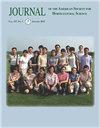Difference in Kernel Shape and Endocarp Anatomy Promote Dehiscence in Pistachio Endocarp
IF 1.1
4区 农林科学
Q3 HORTICULTURE
Journal of the American Society for Horticultural Science
Pub Date : 2023-09-01
DOI:10.21273/jashs05324-23
引用次数: 0
Abstract
A fully split shell in pistachio ( Pistacia vera ) is a trait that is preferred by consumers and is a criterion in evaluating the grade of the pistachio nut. However, although the expanding kernel has been hypothesized to provide the physical force needed for shell split, the mechanisms that control shell split remain unknown. Furthermore, it is intriguing how the shell, or endocarp, splits at the suture ridge when there is no clear dehiscence zone. The objectives of this study were 1) to identify traits associated with dehiscence in fruit in the high-split rate cultivar Golden Hills when compared with the lower split rate cultivar Kerman and determine the anatomic features associated with endocarp dehiscence at the suture region, and 2) to examine the effect of kernel shape on endocarp dehiscence. We determined that, despite the fact that the pistachio endocarp is composed primarily of a single type of polylobate sclerenchyma cell, specialization of cell shape and size at the suture site results in smaller, more flattened cells. We report there is a furrowing of the shell at the dorsal and apical suture sites, where dehiscence initiates. This furrowing is not observed at the ventral suture site or in the indehiscent fruit of Pistacia atlantica , a species that has been used as rootstock for P. vera . In addition, the size of the kernel in the sagittal axis (the width) is strongly associated with a greater split rate. Based on our results, a tentative model emerges in which, in the absence of specialized cell types, cell shape modification can create an anatomically distinct region that is mechanically weak in the endocarp for the initiation of dehiscence, whereas the force from the width of the kernel is necessary for the shell split rate difference as observed in cultivars.果仁形状和内果皮解剖结构的差异促进了开心果内果皮的开裂
开心果(开心果)完全裂开的壳是消费者喜欢的特性,也是评估开心果等级的标准。然而,尽管已经假设膨胀的内核提供了壳分裂所需的物理力,但控制壳分裂的机制仍然未知。此外,令人感兴趣的是,当没有明显的开裂带时,壳或内果皮是如何在缝合脊处裂开的。本研究的目的是:1)比较高裂率品种“金山”与低裂率品种“克尔曼”果实开裂的相关性状,确定其缝合区果皮开裂的解剖学特征;2)研究果仁形状对果皮开裂的影响。我们确定,尽管开心果内果皮主要由单一类型的多叶厚壁组织细胞组成,但细胞形状和大小在缝合部位的特化导致细胞更小,更扁平。我们报告有一个沟壳在背和顶端缝合点,开裂开始的地方。这种沟槽在腹侧缝合处或在阿斯特兰的不裂果实中没有观察到,阿斯特兰是一种被用作真丝木根茎的物种。此外,核在矢状轴上的大小(宽度)与更大的分裂率密切相关。根据我们的研究结果,一个初步的模型出现了,在没有特化细胞类型的情况下,细胞形状的改变可以在内果皮中产生一个解剖学上不同的区域,该区域在机械上弱,用于开裂的开始,而来自核宽度的力对于在栽培品种中观察到的壳分裂率差异是必要的。
本文章由计算机程序翻译,如有差异,请以英文原文为准。
求助全文
约1分钟内获得全文
求助全文
来源期刊
CiteScore
3.80
自引率
0.00%
发文量
31
审稿时长
2 months
期刊介绍:
The Journal of the American Society for Horticultural Science publishes papers on the results of original research on horticultural plants and their products or directly related research areas. Its prime function is to communicate mission-oriented, fundamental research to other researchers.
The journal includes detailed reports of original research results on various aspects of horticultural science and directly related subjects such as:
- Biotechnology
- Developmental Physiology
- Environmental Stress Physiology
- Genetics and Breeding
- Photosynthesis, Sources-Sink Physiology
- Postharvest Biology
- Seed Physiology
- Postharvest Biology
- Seed Physiology
- Soil-Plant-Water Relationships
- Statistics

 求助内容:
求助内容: 应助结果提醒方式:
应助结果提醒方式:


